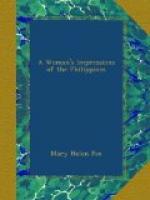We left Honolulu with the modified regret which always must be entertained when other lands are beckoning. The native custom of adorning departing friends with wreaths of flowers was followed, and some of our army belles were almost weighed down with circlets of blossoms cast over their heads by admiring officers of Honolulu. Once clear of the dock and out of eye range, they shamelessly cast these tokens away, and the deck stewards gathered up the perfumed heaps and threw them overboard. The favorite flowers used in these ley, or wreaths, were the creamy white blossoms with the golden centre from which the perfume frangipani is extracted. This flower is known in the Philippines as calachuchi. There were also some of the yellow, bell-shaped flowers called “campanilo,” and a variety of the hibiscus which we learned to call “coral hibiscus,” but which in the Philippines is known as arana, or spider.
The flowers of Honolulu and Manila seem very much alike. In neither place is there a wide variety of garden flowers, but there is an abundance of flowering shrubs and trees.
One quite common plant is the bougainvillaea, which climbs over trellises or trees, and covers them with its mass of magenta blossoms. The scarlet hibiscus, either single or double, and the so-called coral hibiscus grow profusely and attain the size of a large lilac bush. There is another bush which produces clusters of tiny, star-like flowers in either white or pink. It is called in the Philippines “santan,” but I do not know its name in Honolulu.
Catholic missionaries were instrumental in introducing into the Hawaiian Islands a tree of hardy and beautiful foliage which has thrived and now covers a great part of the mountain slopes. This is the algoroda tree, the drooping foliage of which is suggestive of a weeping willow. Then there is the beautiful West Indian rain-tree, which the Honolulu people call the monkey-pod tree, and which in the Philippines is miscalled acacia. Its broad branches extend outward in graceful curves, the foliage is thick but not crowded, and it is an ideal shade tree, apart from the charm of its blossoms of purplish pink.
The fire-tree and the mango are two others which are a joy to all true lovers of trees. The fire-tree is deciduous, and loses its leaves in December, In April or May, before the leaves come back, it bursts into bloom in great bunches of scarlet about the size of the flower mass of the catalpa tree. The bark is white, and as the tree attains the size of a large maple, the sight of this enormous bouquet is something to be remembered. When the leaves come back, the foliage is thick, and the general appearance of the tree is like that of a locust.
Among tropical trees, however, the most beautiful is the mango. Its shape is that of a sharply domed bowl. The leaves are glossy and thickly clustered. It is distinguishable at a long distance by its dignity and grace. But the mass of its foliage is a drawback, inasmuch as few trunks can sustain the weight; and one sees everywhere the great trunk prostrate, the roots clinging to the soil, and the upper branches doing their best to overcome the disadvantages of a recumbent position.




